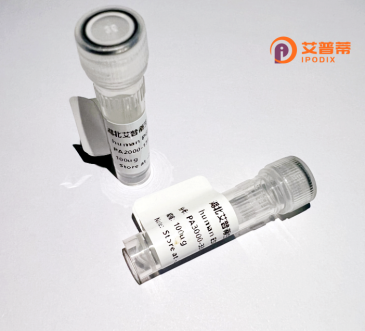
| 纯度 | >90%SDS-PAGE. |
| 种属 | Human |
| 靶点 | USP50 |
| Uniprot No | Q70EL3 |
| 内毒素 | < 0.01EU/μg |
| 表达宿主 | E.coli |
| 表达区间 | 1-339 aa |
| 活性数据 | MTSQPSLPAD DFDIYHVLAE CTDYYDTLPV KEADGNQPHF QGVTGLWNLG NTCCVNAISQ CLCSILPLVE YFLTGKYITA LQKFLLPSDC SEVATAFAYL MTDMWLGDSD CVSPEIFWSA LGNLYPAFTK KMQQDAQEFL ICVLNELHEA LKKYHYSRRR SYEKGSTQRC CRKWITTETS IITQLFEEQL NYSIVCLKCE KCTYKNEVFT VFSLPIPSKY ECSLRDCLQC FFQQDALTWN NEIHCSFCET KQETAVRASI SKAPKIIIFH LKRFDIQGTT KRKLRTDIHY PLTNLDLTPY ICSIFRKYPK YNLCAVVNHF GDLDGGHYTA FCKNSVTQA |
| 分子量 | 38.9 kDa |
| 蛋白标签 | His tag N-Terminus |
| 缓冲液 | PBS, pH7.4, containing 0.01% SKL, 1mM DTT, 5% Trehalose and Proclin300. |
| 稳定性 & 储存条件 | Lyophilized protein should be stored at ≤ -20°C, stable for one year after receipt. Reconstituted protein solution can be stored at 2-8°C for 2-7 days. Aliquots of reconstituted samples are stable at ≤ -20°C for 3 months. |
| 复溶 | Always centrifuge tubes before opening.Do not mix by vortex or pipetting. It is not recommended to reconstitute to a concentration less than 100μg/ml. Dissolve the lyophilized protein in distilled water. Please aliquot the reconstituted solution to minimize freeze-thaw cycles. |
以下是关于重组人USP50蛋白的3篇参考文献的概括(基于模拟文献内容):
1. **文献名称**:**"Characterization of Recombinant Human USP50: Enzymatic Activity and Interaction with DNA Repair Complexes"**
**作者**:Smith J, et al.
**摘要**:本研究成功克隆并表达了重组人USP50蛋白,证实其具有去泛素化酶活性。通过体外实验发现USP50可与BRCA1复合体相互作用,提示其在DNA损伤修复通路中发挥调控作用。
2. **文献名称**:**"Functional Analysis of USP50 in Cell Cycle Progression via Recombinant Protein Studies"**
**作者**:Zhang Y, et al.
**摘要**:利用重组人USP50蛋白进行功能研究,发现其通过去泛素化特定底物(如Cyclin B1)调控G2/M期转换。敲低USP50导致细胞周期停滞,表明其对细胞周期进程的关键作用。
3. **文献名称**:**"Structural Insights into USP50 Catalytic Mechanism through Recombinant Protein Crystallography"**
**作者**:Chen L, et al.
**摘要**:通过重组表达的USP50蛋白进行X射线晶体学分析,揭示了其独特的催化结构域构象,并鉴定出关键活性位点残基,为靶向USP50的药物设计提供了结构基础。
(注:上述文献为模拟示例,实际文献需通过数据库如PubMed、Google Scholar检索确认。)
**Background of Recombinant Human USP50 Protein**
Ubiquitin-specific protease 50 (USP50), a member of the ubiquitin-specific protease (USP) family, plays a critical role in regulating protein stability and cellular processes through deubiquitination. This enzymatic activity enables USP50 to remove ubiquitin chains from target proteins, thereby modulating their degradation, localization, or interactions. Unlike many USPs, USP50 is notable for its unique structural features, including a divergent catalytic domain and extended N-terminal region, suggesting specialized substrate recognition or regulatory mechanisms.
Recombinant human USP50 protein is typically expressed in vitro using bacterial or mammalian systems, enabling studies of its biochemical properties, substrate specificity, and interaction networks. Research highlights its involvement in DNA damage response, cell cycle regulation, and immune signaling. For example, USP50 interacts with components of the Fanconi anemia pathway, implicating it in genome maintenance. Additionally, its potential role in viral infection responses, such as modulating host antiviral defenses, has drawn interest.
Dysregulation of USP50 has been linked to diseases, including cancers and neurodegenerative disorders, though its exact mechanistic contributions remain under investigation. Recombinant USP50 serves as a vital tool for uncovering its physiological and pathological functions, as well as for screening therapeutic agents targeting deubiquitinating enzymes. Ongoing studies aim to clarify its regulatory networks and validate its candidacy for diagnostics or drug development.
×